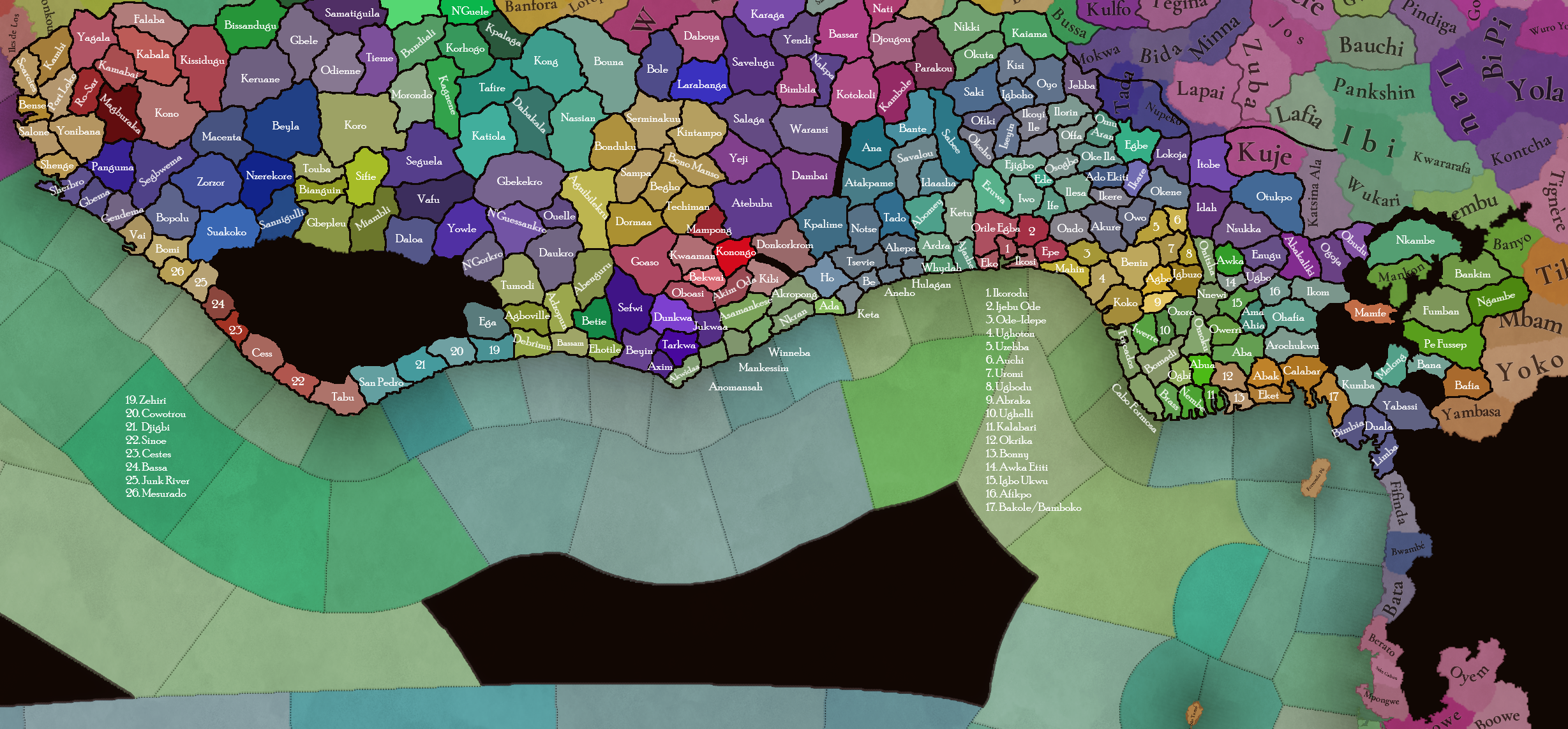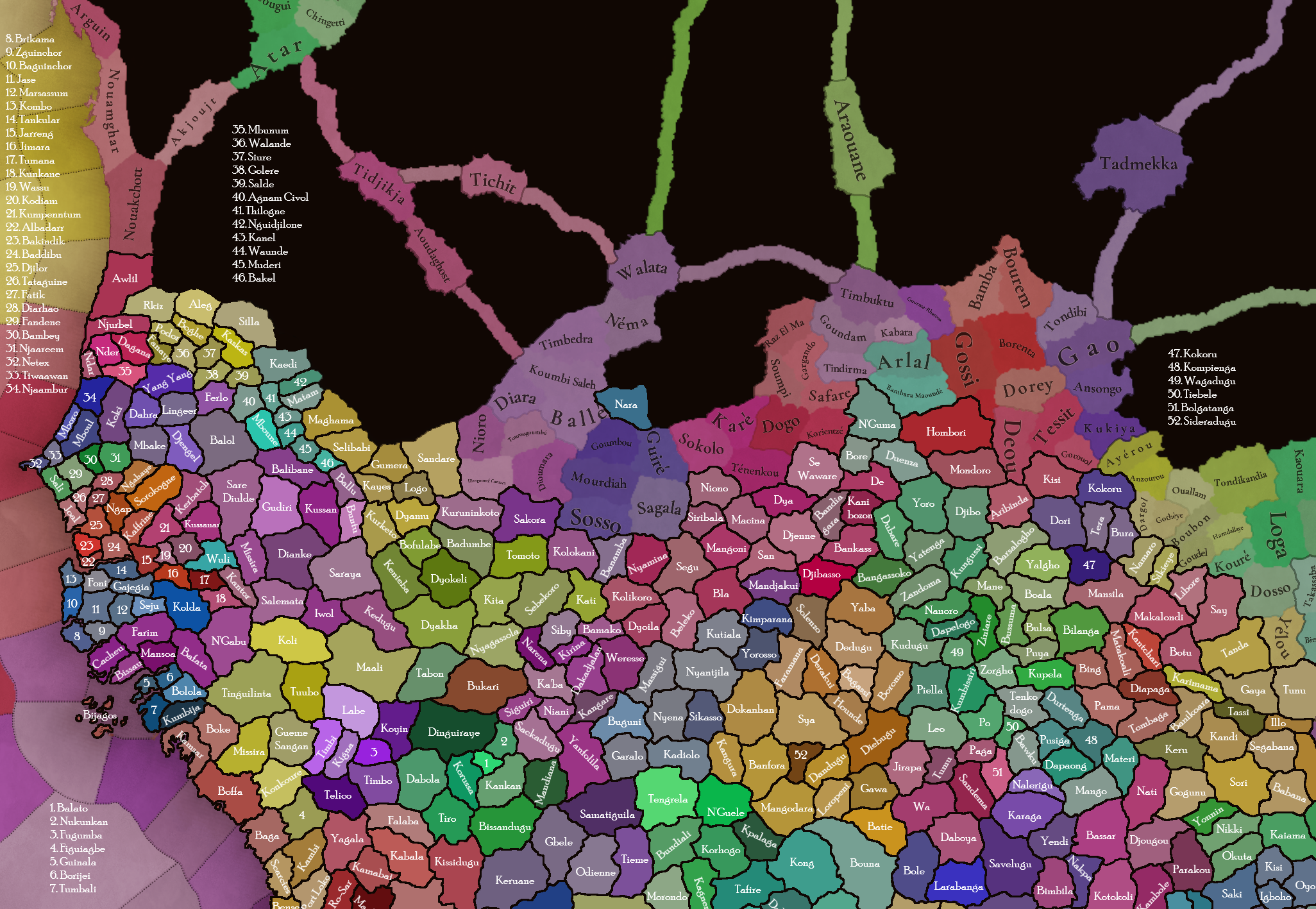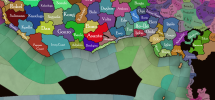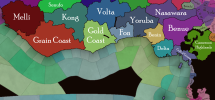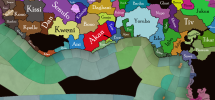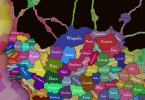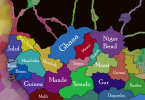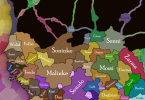Hello, and welcome one more week to Tinto Maps, the day of the week for map nerds lovers! This week we will be taking a look at Western Africa! These lands were named historically in different ways, although probably the most widespread naming was Guinea, which also names the Gulf that makes for the southern limit of the region, with the Atlantic Ocean being to the west, the Sahara desert to the north, and the lands around Lake Chad making for the approximate eastern border.
With these regions, we’re also leaving the ‘Easy Mode Map-Making’ of Project Caesar, as getting comprehensive sources of information for 1337 for most of Sub-Saharan Africa is challenging, as the traditional historical record was oral, in contrast with the written records usual in Eurasia. In any case, we did our best to depict the rich history and geography of the region and its diversity, which is stunning. Let’s start, then!
Countries:

The most important country, and one of the world's great powers, is the Empire of Mali, which in 1337 is at its zenit, still ruled by the infamous Mansa Mūsā. It controls not only the core lands of the Mandé-speaking peoples, but also holds the overlordship over Jolof, most of the fertile Niger river basin, and some of the most important Saharan outposts. To its south-east, the Mossi are organized in several polities (Ougadagou, Gwiriko, Yatenga, Boussouma, Tenkodogo, and Liptako). South into the coast, Kong, Dagbon, Bonoman, and Mankessim are polities ruled by the Dyula, the Dagbani, and the Akan (the last two). To the east, Fada N’gourma, Borgu, and Mamprugu connect with the lands of the Hausa, which rule from several city-states: Kebbi, Gobir, Zafara, Katsina, Daura, Kano, Rano, and Zazzau. Further to the east, the Empire of Kanem rules the lands around Lake Chad from its capital in Njimi, and over some of the Saharan corridors, making it the region's second wealthiest country. And finally, further to the south, there are the lands of the Nupe, the Yoruba (Oyo, Ife, Ijebu, Owo), the Edo (Benin), and the Igbo (Nri).
Dynasties:

The dynasties of the region are a mix of well-known ones, such as the Keita of Mali, the Ndiaye of Jolof, or the Sayfawa of Kanem, and randomly generated ones for the rest of the polities, as we don’t have good enough sources on who was ruling over most of them in 1337.
Locations:



 The locations of Western Africa. We’ve tried our best to find suitable locations, correct naming, etc., although I’m sure there might be plenty of feedback to apply.
The locations of Western Africa. We’ve tried our best to find suitable locations, correct naming, etc., although I’m sure there might be plenty of feedback to apply.
Provinces:

Areas:

Terrain:



This week we have proper Terrain mapmodes at the release of the Tinto Maps… Not much to say about them, though, as the climate and vegetation are pretty straightforward, being divided into Arid and Tropical; while the vegetation goes from desert and sparse beside the Sahara, to increasingly more forested terrain, until reaching the tropical jungles by the coast. The topography is not very fragmented, with the Guinean Highlands and the Adamawa Plateau being the most important landmarks.
Natural Harbors:

A new map mode this week, coming from the latest Tinto Talks! There are some decent natural harbors in the region, with Banana Islands (where Freetown would be founded), Elmina, and Calabar being the best ones.
Cultures:

A beautiful map this week… I may repeat that we tried our best to approach the region, taking into account that this was the first African region we completed, around 3 years ago. When we review it, we may add some more diversity, as we have now some more tools than the ones we had back in time, but we think that it’s way best to read your feedback first, to make sure we are on the same page.
Religions:

Take this map as very WIP. The Sunni-Animism division is kind of accurate, with the expected division for 1337 (Islam would later on advance more to the South, but we think this is the best for this date). What we have yet to do is to divide the ‘Animism’ population into some of the regional variants; we already have plenty of data, but we also want to read your feedback on this first.
Raw Materials:

The goods of the region are quite diverse and very dependent on the geography. In the Saharan lands, there are plenty of locations with resources such as Salt, Copper, or Alum (regarding this resource, the lands to the north of Lake Chad make for the densest Alum hub in the world for 1337, something the historical sources talk about). Livestock is king in the Sahelian lands, while there are plenty of agricultural goods in the Niger river basin. The region is also full of luxury goods, of which Gold is the most relevant, as being the biggest supply of this metal to the Mediterranean and Europe in the Late Middle Ages, while also having others such as Ivory, Gems, or Spices (which in this region are portraying some goods such as kola nuts, or malagueta pepper). Finally, the coasts of the Gulf of Guinea have plenty of Fish. Maybe the only type of good that is not very abundant in the region is metals, as having some Iron, Tin, etc., but not much in comparison with other regions.
Markets:

Markets of the region, have an interesting distribution. The most important ones in 1337 are Niani, Kano, and Njimi, which are also connected to the Northern African markets, making it possible to get plenty of wealth by exporting well-demanded goods throughout the Sahara (for instance, exporting Gold or Alum for good money is a very viable strategy ATM). Later on, after the Age of Discovery, the coastal markets may get connected to other markets, making them more relevant, and maybe switching the power balance of the region from the North to the South, as historically happened (but take it as a ‘maybe’, not for granted, OFC!).
Population:




 Population of the region. We’ve improved a bit our tracking of the population data, to avoid further problems like the one we had with Germany. I can tell you that the total population of Western Africa is around 5.6M people, which is divided into 2.2M for the Sahel, and 3.3M for the coast of Guinea. You may very well notice that the hegemonic power here may be Mali, with around 700k people, but also that there are many more people not living under the rule of a polity, than living under it, which will make for interesting gameplay on how to deal with it (more about this in a later Tinto Talks, soon…).
Population of the region. We’ve improved a bit our tracking of the population data, to avoid further problems like the one we had with Germany. I can tell you that the total population of Western Africa is around 5.6M people, which is divided into 2.2M for the Sahel, and 3.3M for the coast of Guinea. You may very well notice that the hegemonic power here may be Mali, with around 700k people, but also that there are many more people not living under the rule of a polity, than living under it, which will make for interesting gameplay on how to deal with it (more about this in a later Tinto Talks, soon…).
And, speaking of that, I have the sad news that next Friday there is a bank holiday here in Spain, so there won’t be a Tinto Maps. The next one will be on Friday 23rd, and we will be taking a look at Eastern Africa! Until then, you may still stay tuned, as we will be replying to feedback, as usual, and we may have some informal maps incoming. Cheers!
With these regions, we’re also leaving the ‘Easy Mode Map-Making’ of Project Caesar, as getting comprehensive sources of information for 1337 for most of Sub-Saharan Africa is challenging, as the traditional historical record was oral, in contrast with the written records usual in Eurasia. In any case, we did our best to depict the rich history and geography of the region and its diversity, which is stunning. Let’s start, then!
Countries:

The most important country, and one of the world's great powers, is the Empire of Mali, which in 1337 is at its zenit, still ruled by the infamous Mansa Mūsā. It controls not only the core lands of the Mandé-speaking peoples, but also holds the overlordship over Jolof, most of the fertile Niger river basin, and some of the most important Saharan outposts. To its south-east, the Mossi are organized in several polities (Ougadagou, Gwiriko, Yatenga, Boussouma, Tenkodogo, and Liptako). South into the coast, Kong, Dagbon, Bonoman, and Mankessim are polities ruled by the Dyula, the Dagbani, and the Akan (the last two). To the east, Fada N’gourma, Borgu, and Mamprugu connect with the lands of the Hausa, which rule from several city-states: Kebbi, Gobir, Zafara, Katsina, Daura, Kano, Rano, and Zazzau. Further to the east, the Empire of Kanem rules the lands around Lake Chad from its capital in Njimi, and over some of the Saharan corridors, making it the region's second wealthiest country. And finally, further to the south, there are the lands of the Nupe, the Yoruba (Oyo, Ife, Ijebu, Owo), the Edo (Benin), and the Igbo (Nri).
Dynasties:

The dynasties of the region are a mix of well-known ones, such as the Keita of Mali, the Ndiaye of Jolof, or the Sayfawa of Kanem, and randomly generated ones for the rest of the polities, as we don’t have good enough sources on who was ruling over most of them in 1337.
Locations:




Provinces:

Areas:

Terrain:



This week we have proper Terrain mapmodes at the release of the Tinto Maps… Not much to say about them, though, as the climate and vegetation are pretty straightforward, being divided into Arid and Tropical; while the vegetation goes from desert and sparse beside the Sahara, to increasingly more forested terrain, until reaching the tropical jungles by the coast. The topography is not very fragmented, with the Guinean Highlands and the Adamawa Plateau being the most important landmarks.
Natural Harbors:

A new map mode this week, coming from the latest Tinto Talks! There are some decent natural harbors in the region, with Banana Islands (where Freetown would be founded), Elmina, and Calabar being the best ones.
Cultures:

A beautiful map this week… I may repeat that we tried our best to approach the region, taking into account that this was the first African region we completed, around 3 years ago. When we review it, we may add some more diversity, as we have now some more tools than the ones we had back in time, but we think that it’s way best to read your feedback first, to make sure we are on the same page.
Religions:

Take this map as very WIP. The Sunni-Animism division is kind of accurate, with the expected division for 1337 (Islam would later on advance more to the South, but we think this is the best for this date). What we have yet to do is to divide the ‘Animism’ population into some of the regional variants; we already have plenty of data, but we also want to read your feedback on this first.
Raw Materials:

The goods of the region are quite diverse and very dependent on the geography. In the Saharan lands, there are plenty of locations with resources such as Salt, Copper, or Alum (regarding this resource, the lands to the north of Lake Chad make for the densest Alum hub in the world for 1337, something the historical sources talk about). Livestock is king in the Sahelian lands, while there are plenty of agricultural goods in the Niger river basin. The region is also full of luxury goods, of which Gold is the most relevant, as being the biggest supply of this metal to the Mediterranean and Europe in the Late Middle Ages, while also having others such as Ivory, Gems, or Spices (which in this region are portraying some goods such as kola nuts, or malagueta pepper). Finally, the coasts of the Gulf of Guinea have plenty of Fish. Maybe the only type of good that is not very abundant in the region is metals, as having some Iron, Tin, etc., but not much in comparison with other regions.
Markets:

Markets of the region, have an interesting distribution. The most important ones in 1337 are Niani, Kano, and Njimi, which are also connected to the Northern African markets, making it possible to get plenty of wealth by exporting well-demanded goods throughout the Sahara (for instance, exporting Gold or Alum for good money is a very viable strategy ATM). Later on, after the Age of Discovery, the coastal markets may get connected to other markets, making them more relevant, and maybe switching the power balance of the region from the North to the South, as historically happened (but take it as a ‘maybe’, not for granted, OFC!).
Population:




And, speaking of that, I have the sad news that next Friday there is a bank holiday here in Spain, so there won’t be a Tinto Maps. The next one will be on Friday 23rd, and we will be taking a look at Eastern Africa! Until then, you may still stay tuned, as we will be replying to feedback, as usual, and we may have some informal maps incoming. Cheers!



